








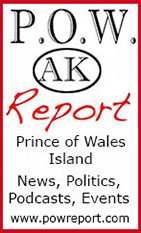

 Contact Contact 
 Webmail
Letters Webmail
Letters
 News Tips News Tips
 Copyright Info Copyright Info
 Archives Archives
Quick News
Search
 Alaska Alaska
 Ketchikan Ketchikan
 SE Alaska SE Alaska
Columns
- Articles
 Dave Kiffer Dave Kiffer
 Money Matters Money Matters
Historical
Ketchikan
 June Allen June Allen
 Dave
Kiffer Dave
Kiffer
 Louise
B. Harrington Louise
B. Harrington
Sports
 Ketchikan Links Ketchikan Links
Public Records
 FAA Accident Reports FAA Accident Reports
 NTSB
Accident Reports NTSB
Accident Reports
 Court Calendar Court Calendar
 Recent Filings & Case Dispositions Recent Filings & Case Dispositions
 Court Records Search Court Records Search
 Sex Offender Reg. Sex Offender Reg.
 Public Notices Public Notices
 Alaska Recall Alerts Alaska Recall Alerts
 Recalls.gov Recalls.gov
 AST Daily Dispatch AST Daily Dispatch
 KTN
Police Reports KTN
Police Reports
 Juneau Police Reports Juneau Police Reports
Weather,
Webcams
 Today's
Forecast Today's
Forecast
 KTN
Weather Data KTN
Weather Data
 AK
Weather Map AK
Weather Map
 AK Weathercams AK Weathercams
 AK Earthquakes AK Earthquakes

|
|

Sunday
May 22, 2022

Norwegian Encore
The cruise ship pulling into dock at Ward Cove on Friday
SitNews Front Page Photo By STEVE SPEIGHTS ©2022
To have your photo featured on the front page,
email your photo(s) to editor@sitnews.us |
 COVID-19 DATA SUMMARY May 18, 2022 COVID-19 DATA SUMMARY May 18, 2022
Reporting data for May 11-17, 2022
STATEWIDE OVERVIEW: 1,954 new cases - 18 deaths (of those 2 in Ketchikan[male in his 70s and a male in his 40s], 1 in Petersburg [a female in her 80s]) - 44 new hospitalizations
SE Alaska Positive Cases:
Juneau (246), Ketchikan (74), Ketchikan Gateway Borough (2), Metlakatla (5), Petersburg (3), Sitka (54), POW-Hyder Census Area (2), Skagway (24), Haines (9), Wrangell (8), Yakutat plus Hoonah-Angoon (24)
 COVID-19 DATA SUMMARY May 11, 2022 COVID-19 DATA SUMMARY May 11, 2022
Reporting date for May 4-10, 2022
STATEWIDE OVERVIEW – 1,629 new cases - 15 new deaths, 41 new hospitalizations
SE Alaska positive cases: Juneau (151), Ketchikan (54), Ketchikan Gateway Borough (1), Metlakatla (9), Petersburg (5), POW-Hyder Census Area (2), Sitka (69), Skagway (15), Wrangell (10), Angoon (6), Haines (5),
 COVID-19 DATA SUMMARY May 04, 2022 COVID-19 DATA SUMMARY May 04, 2022
Reporting data for April 27-May 03, 2022
 COVID-19 DATA SUMMARY – Apr. 27, 2022 COVID-19 DATA SUMMARY – Apr. 27, 2022
Reporting data for Apr. 20 - Apr. 26, 2022
 COVID-19 DATA SUMMARY Apr. 20, 2022 (Weekly) COVID-19 DATA SUMMARY Apr. 20, 2022 (Weekly)
Reporting data for Apr. 13 - Apr. 19, 2022
 COVID-19 DATA SUMMARY Apr. 13, 2022 COVID-19 DATA SUMMARY Apr. 13, 2022
Reporting data for Apr. 5 - Apr. 12, 2022
 COVID-19 DATA SUMMARY Apr. 6, 2022 COVID-19 DATA SUMMARY Apr. 6, 2022
Reporting data for Apr. 1 - Apr. 4, 2022
 COVID-19 DATA SUMMARY COVID-19 DATA SUMMARY
APRIL 01, 2022
Reporting data for Mar. 30 - Mar. 31, 2022
 COVID-19 DATA SUMMARY – Mar. 30, 2022 COVID-19 DATA SUMMARY – Mar. 30, 2022
Reporting data for Mar. 25 - Mar. 29, 2022
 Alert Levels Alert Levels
 Case Counts Dashboard Case Counts Dashboard
 Information Hub Information Hub
 Alaska: Statewide COVID-19 Alert Levels, Updates, Active Cases, Hospitalizations, etc. Alaska: Statewide COVID-19 Alert Levels, Updates, Active Cases, Hospitalizations, etc.
Ketchikan: Public Meetings
Ketchikan: Upcoming Events
Ketchikan: Announcements
Ketchikan: Classifieds
Historical
Ketchikan
 June Allen June Allen
 Dave
Kiffer Dave
Kiffer
 Louise
B. Harrington Louise
B. Harrington
Ketchikan Weather
 Ketchikan's
Forecast Ketchikan's
Forecast
 Ketchikan Dec. Weather Ketchikan Dec. Weather
 Ketchikan 2021 Daily & Monthly Data (Choose the Location of Interest) Ketchikan 2021 Daily & Monthly Data (Choose the Location of Interest)
 Nat Weather Service KTN Nat Weather Service KTN
 Ketchikan Tides & Currents Ketchikan Tides & Currents
 Tideschart Tideschart
 Sunrise - Sunset Ketchikan Sunrise - Sunset Ketchikan
Search the News
 Ketchikan Ketchikan
 Alaska Alaska
 SitNews Search SitNews Search
|
Alaska: 32nd Session Ends: Legislature agrees on budget, confirms Dunleavy Administration priorities Posted & Edited By MARY KAUFFMAN -
The 32nd Session of the Alaska Legislature ended Wednesday (May 18th) with the completion of a wide range of Governor Mike Dunleavy’s legislative and policy priorities that will move Alaska towards a more secure and stable future.
“This year’s session was the culmination of a four-year effort to bring a greater degree of accountability to public education, continual improvements to the public safety system and rebuilding Alaska’s economy,” said Governor Dunleavy.
Dunleavy said, “Once again, I thank those legislators who prioritized Alaskan’s needs over everything else. Our families are experiencing runaway inflation, soaring fuel prices and economic fallout – they are trying to budget accordingly. Although not a statutory PFD, $3,200 was agreed upon by the Legislature making it the largest PFD to date. This PFD, for a family of four, equates to $12,800 which should assist significantly with battling high rates of inflation.”
Legislative Successes for Alaskans:
Public Safety – Protecting all Alaskans
The budget has continued investments in public safety built upon Governor Dunleavy’s commitment to protect rural and urban Alaskans. New state trooper and VPSO positions will restore the positions eliminated by the previous administration and further restore confidence in the state’s public safety system.
Senate Bill 7, sponsored by Senator Elvi Gray-Jackson (D-Anchorage) requiring the Department of Public Safety to publish current policies and procedures related to the conduct of peace officers employed or regulated by the Department. Senate Bill 7 is part of a package of legislation called Turning Pain Into Progress that stems from the national 8 Can’t Wait initiative.
“This is just one step to building a stronger relationship between the public and law enforcement. When we look at these policy changes, it is critical that we protect our communities and law enforcement officers equally,” said Sen. Gray-Jackson. “This, along with the other pieces of Turning Pain Into Progress, helped develop a dialogue with law enforcement agencies throughout the state and the communities they swore to protect and serve. The progression of these efforts will build better relationships and standards such as preventing the over-policing of Black, Indigenous, and People of Color communities.”
Other legislative components of Turning Pain into Progress iclude:
- SB1 - Banning the use of chokeholds
- SB2 - Requires de-escalation procedures and provides a duty to intervene by officers that observe other officers violating practice standards
- SB 3 - Requiring a peace officer to exhaust all possible alternatives and provide an oral warning before discharging a firearm
- SB 4 - Banning shooting at moving vehicles
- SB 46 - Requiring comprehensive reporting by officers each time they use of threaten to use force, establishes a "use force database" for the Department of Public Safety, Department of Corrections, municipal officers, and municipal correctional officers, and requires those agencies to search the database before employing a new peace officer.
The State Legislature completed a major overhaul of Alaska's outdated public safety statutes. House Bill 325, sponsored by Representative Sara Rasmussen, addresses many of the deficiencies in current criminal statutes, which currently hinder prosecutors from seeking charges in cases of domestic violence and sexual assault.
“For too long, Alaska has led the nation in the highest rates of domestic violence and sexual assault. With the passage of HB 325 we are taking the necessary steps to protect women in Alaska,” said Representative Sara Rasmussen (R-Anchorage). “Finally, no will mean no. I hope this sends a clear message that rape and sexual assault will not be tolerated in our state any longer.”
"This change to the consent law will impact every sexual assault case in the state because establishing consent is a key element of these crimes," said Representative Geran Tarr (D-Anchorage). "This important legislation fixes three key elements of our broken consent statute to an affirmative definition that consent is a freely given, reversible agreement, removes the use of force from the definition and makes it an element of the crime, and creates a victim centered approach. The current, more than 40 year old statute routinely denies justice to Alaskans and we are fixing that. The bill also establishes the crime of rape by fraud and contains the last piece of our multi-year rape kit reform initiative to require rape kits be tested within six months."
The original bill changes statute to acknowledge the severity of “revenge porn,” in which an abusive individual distributes (or threatens to distribute) explicit images of their partner in an attempt to control, humiliate, or otherwise harm that person. HB 325 redefines this type of behavior as domestic violence, as it has the potential to negatively impact the victim’s life and future.
HB 325 was amended in the Senate to include many of the components of House Bill 5, sponsored by Rep. Geran Tarr (D-Anchorage), and Senate Bill 187, Governor Dunleavy’s criminal justice legislation. These changes include modernizing Alaska’s definition of consent to be a freely given, reversible agreement, specific to the conduct at issue. Alaska’s consent definition currently requires that use of force must be proven in order to prosecute a case of sexual assault. This updated definition modernizes this statute and acknowledges that “freezing” is also a common reaction to a traumatic situation.
This bill also criminalizes what is known as “rape by fraud,” in which an offender impersonates a person known to another individual in order to obtain sex, when that individual would not have otherwise consented. Under current Alaska law, this kind of deceptive behavior would not be prosecutable.
Additionally, HB 325 expedites the processing of rape kits in order to ensure timely justice and answers for victims of sexual assault. Under current statute, rape kits must be processed within a year of receipt. After the passage of HB 325, that timeline will be decreased to 6 months.
There were other amendments added to HB 325 by Senator Roger Holland (R-Anchorage). His amendment requires that an individual seeking to change their name must notify the courts about any charges, parole/probation status, and/or registered sex offender status, and the name change must not be done with fraudulent or criminal intent. Another amendment from Sen. Holland also would require the lifetime revocation of a teaching certificate for individuals who possess and/or distribute child pornography.
"The ANDVSA would like to thank the legislators for passing legislation to strengthen Alaska's response to sexual assault by a unanimous vote in each body," said Brenda Stanfill, Executive Director for ANDVSA. "We appreciate Rep. Tarr’s leadership in this critical area and think these are first steps in aligning the justice system’s response to new community norms- Yes means yes."
"I’d like to take the opportunity to say thank you to Representative Geran Tarr and her amazing staff David Song for their hard work and dedication to seeing HB5 passed the finish line. It is my sincere hope, as a strong advocate for HB5 that victims of sexual assault can finally be comforted knowing that State law believes in them and also support victims of sexual assault because it’s long overdue," said Katie Botz, sexual assault survivor advocate.
"I am glad the state defined consent, and ended many loopholes which were allowing perpetrators to keep hurting people. This law will now be able to help bring justice to so many people," said Niviaaluk Brandt of Nome, survivor and advocate.
"This law was made in partnership with survivors, advocates, law enforcement and health professionals. Our voices are in this bill," said advocate Lisa Ellanna of Nome. "After years of advocacy, our leaders have heard our voices! Thank you to the legislators who did the tireless hard work to make justice a reality! It's a relief knowing our prosecutors now have the tools they need to protect citizens and hold perpetrators accountable!"
“We are absolutely elated about the passing of House Bill 5, and the elements it includes that address affirmative consent, rape by impersonation becoming illegal, shortened timeline for the processing of rape kits, notification of victims when their offender changes their name, and other loopholes making sexual violence more prosecutable," said Jennifer Brown, STAR Development Manager.
"Recent data from the 2020 Alaska Victimization Survey states that 41 out of every 100 adult women who reside in Alaska has experienced sexual violence in their lifetime representing 106,937 Alaska women. These numbers are unacceptable. It is critical that Alaska continues to improve and strengthen their laws to reduce and end sexual violence in our state," said Council Chair Blaze Bell and Executive Director Diane Casto in a statement from Alaska's Council on Domestic Violence and Sexual Assault (CDVSA).
"For these reasons, CDVSA strongly supported HB 5 and are extremely proud of Representative Tarr for her work on changing Alaska’s consent laws and commend the House and Senate for their strong support to revise Alaska’s outdated consent laws. These changes will save women’s live and improve outcomes for all victims and survivors of sexual assault."
HB 325 now goes to the Governor’s desk to be signed into law.
People First Initiative – Safety and Prevention
Governor Dunleavy announced the People First Initiative late last year to address domestic violence, sex trafficking, missing and murdered Indigenous persons, homelessness and foster care. With the administration’s combative efforts against sexual assault in Alaska, Governor Dunleavy was pleased to see the passing of House Bill 325. Sponsored by Representative Sara Rasmussen, the bill contained three components of the Governor’s Victim Rights Crime package – consent definition update, protection of crime victims, and revoking teaching certificates from individuals who committed certain sex crimes. House Bill 172 also passed the Legislature. For the first time in Alaska, people will have somewhere to go besides a jail cell or an ER gurney.
2022 PFD
Although 44 out of 60 legislators voted for a $3,850 dividend, the final amount of $3,200 will still be welcomed by Alaskans said Gov. Dunleavy. The budget compromise includes a $2500 Permanent Fund Dividend - half of the 5 % draw of the Permanent Fund's overall value that lawmakers have designated for spending. It also includes a one-time energy relief assistance for every dividend recipient.
Again, Governor Dunleavy believes government should put people first in all of its decisions. While 16 legislators voted against this idea, including Ketchikan's Rep. Dan Oriiz, the vast majority of legislators did put Alaskans first and agreed upon the largest dividend in Alaska’s state history.
“The budget process is messy, and no budget is perfect,” said Governor Mike Dunleavy. “However, the Senate’s focus on the people of Alaska should be commended. I thank the 15 members of the Senate who voted with the people in mind first and foremost. This Permanent Fund Dividend is one of the largest in state history, and it’s coming at a time when people are facing record-high inflation, cost of living increases, and other disruptive events around the world. I hope that the House also recognizes the difficult times people are in and that the windfall the state enjoys will be shared through the dividend fund to alleviate some of the burdens.”
Alaska Reads Act – Accountability
The Legislature also passed the Alaska Reads Act, championed by the Governor and a host of bipartisan Legislators, to ensure expected reading outcomes for our kids. This legislation moves Alaska into putting the needs of children first and foremost.
The Alaska Reads Act includes universal, voluntary pre-K, a reading intervention program, and an increase to the Base Student Allocation (BSA) for the first time since 2016. Members of the Alaska State legislature issued the following comments:
“This is a win for all Alaskan children. Through countless hours of work and committee hearings, I am proud of this accomplishment by the Alaska legislature,” said Senate President Peter Micciche, (R-Soldotna). “We cannot sit back and continue to think that doing nothing will improve education. Passing the Alaska Reads Act will improve Alaska’s educational outcomes and give every Alaskan student a chance to start school ready for success.”
“I am very pleased that the House was able to complete the process of this landmark legislation. This will improve education outcomes for decades to come,” said Senator Roger Holland, Chairman of the Senate Education Committee, (R-Anchorage). “Through a bipartisan effort, we have provided the tools for all Alaskan children to be ready to read by nine.”
Working collaboratively across party lines, the Alaska Reads Act is a bold move in education,” said Senator Tom Begich, (D-Anchorage). “I am proud of the work of both education committees. I am thankful for the energy and efforts of our education stakeholders. I am honored to have walked beside these student-centered advocates to bring forth the single largest investment in Alaska’s most valuable resource, our children, in years.”
" Tonight [May 18th], the Alaska State legislature passed legislation focused on the early learning career of children to ensure students can read proficiently by 4th grade. The passage of the Alaska Reads Act is the result of years of hard work by stakeholders across the state to improve educational outcomes ,” said Representative Chris Tuck , (D-Anchorage).
Alaska Statehood Defense – Protecting Our Sovereignty
The FY23 budget allocates $2.5 million to the Alaska Department of Law to defend Alaska from undue federal encroachment into Alaska’s sovereignty. The Biden Administration has taken unprecedented moves to shut down Alaska’s resource-based economy. Alaska must do everything it can to defend the State’s rights to sustainably manage Alaska’s vast and abundant resources as promised at statehood to ensure that subsistence lifestyles are maintained into the future.
Capital Budget – Critical Infrastructure
The capital budget passed by the Legislature secures funding for critical infrastructure in Alaska port roads and essential corridors of commerce and national security.
“There's something in this budget for every Alaskan to be excited about," said Speaker Louise Stutes (R-Kodiak). "The Alaska Marine Highway System is fully funded. We're putting money down to forward fund K-12 education and refilling the Higher Education Investment Fund. And most importantly we're putting money in our savings to prepare for the eventual drop in oil prices."
"I'm proud that the priorities this caucus fought for when we crafted our budget were maintained, especially our focus on education, " said Rep. Dan Ortiz (I-Ketchikan), a member of the HB 281 conference committee. "Forward funding the K-12 system will give sighs of relief to the teachers, students, and families that have to battle the year-to-year uncertainty if classes are going to start on time.
Funding sources for the Alaska Marine Highway and Alaska higher education scholarships are nearly off the table from future political fights. House Bill 322 passed the Legislature , which is designed to protect the Alaska Marine Highway and Higher Education Investment funds from the annual Constitutional Budget Reserve sweep.
The Constitutional Budget Reserve (CBR) sweep provision, established in the Alaska Constitution, requires that money in the general fund available for the appropriation at the end of each fiscal year be swept, or repaid, to the CBR. While the sweep is reversible by a 3/4 vote of the legislature, that outcome has become difficult to achieve in recent years. Moreover, funds previously held harmless from the annual repayment have since been interpreted as subject to the sweep, destabilizing crucial ongoing state services and longstanding funds.
HB 322 removes the Alaska Marine Highway System (AMHS) Fund, the AMHS Vessel Replacement Fund, and the Higher Education Investment Fund (HEIF) from the equation by moving them from the state’s general fund to the state treasury.
“When Alaskans chart their trips on the Marine Highway, they want to know that the ferry schedule will be reliable and robust," said Speaker Louise Stutes (R - Kodiak). "This legislation will help ensure the Marine Highway System consistently serves Alaskans, without a yearly fight over funding, while allowing AMHS to bank farebox receipts into an endowment that will help rebuild our fleet."
“Alaska’s youth shouldn’t have to worry that the scholarships they were counting on to become our next generation of doctors, nurses, scientists and business leaders is arbitrarily on the chopping block each year," said Representative Andy Josephson (D - Anchorage).
"The recipients of the merit-based Alaska Performance Scholarships and the needs-based Alaska Education Grants reward our best and brightest and assist those who are looking to advance their education," said Representative Bart LeBon (R - Fairbanks). "We should promote every opportunity to keep the next generation of Alaskans here in Alaska."
HB 322 passed the Senate with a vote of 14-4 and goes to Governor Dunleavy's desk for his consideration and signature.
Some additional iems included in the budget: - More...
Sunday - May 22, 2022
|
|
Southeast Alaska Adventure: Bear in the Darkness: Encounters with a True Alaskan Giant By BJORN DIHLE - I woke to the sound of a brown bear crackling through brush near my tent. It was early April and I was guiding a small natural history film crew on an island in Southeast Alaska. We were at the beginning of three weeks of filming, and our primary goal was to film brown bears feeding on a humpback whale carcass. I grabbed my flare gun and .44 pistol, unzipped the tent and crawled out into the black night. The bear paused seven yards away, then took a step or two closer. He showed no signs of agitation. His breathing was steady, there was no huff, jaw-popping or growl. He knew he was safe and that he had the advantage in the darkness. Another step or two and I would slowly rise and gently suggest he leave. I sensed the bear turning away. Branches snapped and cracked as he made his way deeper into the rainforest. I waited outside the tent for ten minutes, listening to the quiet of the falling snow.
I wondered if the bear had been the “giant.” I’d seen the giant’s tracks nearby while my two companions and I had set up camp a few days before. The prints were bigger than any brown bear tracks I’d seen. I’ve been working with brown bears for more than a decade, beginning with guiding wildlife photographers and for the last few years working solely with natural history film crews. I spend most of my time in Southeast Alaska, but I’ve also explored some of Kodiak Island and the Alaska Peninsula where the biggest brown bears in North America live. The giant was an anomaly, a mountain of a bear, the sort of beast more commonly seen in dreams than reality.
In the gray dawn, I studied previous night’s visitor’s tracks in the snow and on the nearby black sand beach. It was early in the year for bears. Most of those we’d seen so far were adult males, who wake up earliest. Females, especially those with cubs, generally come out of their dens in May. Last night’s camp visitor had been a very large male—probably a nine-foot bear—but he was not the giant, which was easily a foot bigger. Massive schools of herring had spawned in the sound and turned the water milky. The beach by our camp was covered in a few feet of herring eggs. The eggs are traditionally harvested by the Indigenous peoples of Southeast Alaska, as well as targeted by a commercial fleet, and are a delicious delicacy, so I was worried bears would congregate to feast. Last night’s bear had walked though the piles of eggs but not eaten any. Surprisingly, we would see no evidence of bears feeding on herring eggs in the days to come.
We were exposed to the stormy expanse of the Pacific Ocean. Wind and snow alternating with rain hammered us for the first ten days. We suffered the elements, staking out the whale carcass when the wind was from the south. When the wind switched to the north, we changed locations and hid downwind of a dead sea lion that the stormy sea had tossed high on the beach. The bears mostly came out at night. We saw a half dozen during dusk and dawn but couldn’t get any usable footage. Some were large males, but none were the giant.
The weather broke and overnight spring arrived. Hundreds of gray whales arrived to feed on the eggs herring had laid to any solid surface beneath the ocean. We met two guys who work for Fish and Game surveying winter-killed deer. They were blown away by the amount of gray whales. Migrating shorebirds rested and picked through the mounds of herring eggs. Sitka blacktail deer emerged from the forest and browsed the high tide line—a few times it appeared they, too, were eating kelp covered with herring eggs. Bears are generally more active at dusk and dawn, so we’d usually make the two-mile hike from the whale carcass to camp in the dark. Sometimes we were treated to the northern lights streaming green above snow-covered mountains.
- More...
Sunday - May 22, 2022
|
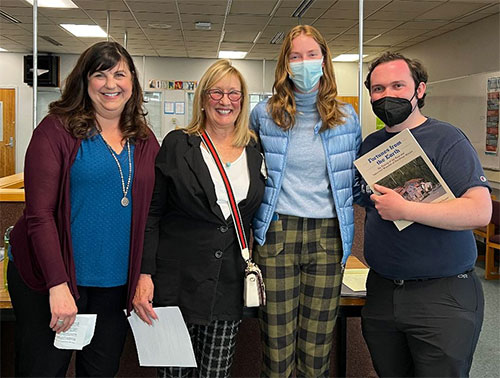
Tongass Historical Society's Patricia Roppel Memorial Scholarship of $5,000 awarded to Peter Stanton
Laurie Pool, Rosie Roppel, Samantha Baird and Peter Stanton
Photo courtesy Tongass Historical Society |
|
Ketchikan: Tongass Historical Society's Patricia Roppel Memorial Scholarship of $5,000 awarded to Peter Stanton -
Peter Stanton a high achieving scholar and a graduate from Ketchikan High School has been awarded the Tongass Historical Society's Patricia Roppel Memorial Scholarship.
Stanton teaches history at Ketchikan High School; however, he is currently taking a sabbatical to write a history book on Southeast Alaska Tlingits.
Pat Roppel, a former teacher at Ketchikan High School, would have been pleased to know that Stanton is receiving this scholarship of $5,000 to help out with his research to also write another Southeast Alaska book on the Tlingits and hopefully using it in his classroom at Ketchikan High School (Kayhi).
Laurie Pool, president of Tongass Historical Society (THS) said in partnership with the Roppel family and the Eichner family, we were honored to establish the Tongass Historical Society's Patricia Roppel Memorial Scholarship with the Alaska Community Foundation in 2016. This scholarship was established to honor the late historian and scholar Pat Roppel. Not only was she a prolific writer and scholar, but she served on the Tongass Historical Society's board, made significant donations of objects, information, time, money, and was a supportive member for over fifty years.
Rosie Roppel, THS board member and scholarship chair and Patricia’s sister-in-law said, "Historian and scholar Pat Roppel was a prolific writer on Southeastern Alaskan history." Pat Roppel wrote 14 books and hundreds of articles on all kinds of things including children’s magazines. Pat Ropell presented 60 percent of the research that went into a most recent book called Tin Can said Rosie Roppel. - More...
Sunday - May 22, 2022
Ketchikan: PeaceHealth Ketchikan pediatricians offer suggestions on weathering the national infant formula shortage -
Since the outbreak of COVID-19, there have been significant shortages of infant formulas in some stores. Current shortages have been largely caused by supply chain issues and a recall of several contaminated baby formula products. The local PeaceHealth primary care teams have been following this problem and working to identify regional resources for families.
Worrying about how to safely feed your infant is a frightening experience. Pediatrician Tim Horton, MD, shared, “I am hopeful the formula shortages will be alleviated soon. In the meantime, please reach out to your pediatric team if you have questions about alternate feeding options until your preferred formula is restocked.”
With recent national media attention around the formula shortage, PeaceHealth pediatricians offer some safety tips and possible resources for families. Most importantly, anyone with questions about safe infant feeing practices should contact their baby’s primary care provider for guidance. - More...
Sunday - May 22, 2022
What you need to know about the Defense Production Act – the 1950s law Biden invoked to try to end the baby formula shortageBy ERIC GORDON - U.S. President Joe Biden on May 18, 2022, announced he is invoking the Defense Production Act to help end the shortage of baby formula stressing out parents nationwide.
He said he will direct suppliers of baby formula ingredients to prioritize delivery to formula manufacturers and control their distribution as necessary.
You might well wonder what babies going without formula has to do with defense production, which calls to mind big warships and weapons systems. While using the Defense Production Act to force companies to make baby formula would certainly be a novel use of the act, it would hardly be the first time the postwar law has been used beyond its originally intended purpose to support national defense.
And in fact, the law is used a lot more frequently than you might think. But as a business professor who studies strategies to maximize efficient allocation of resources, I believe when presidents invoke the act it’s often more about political theater – showing the public you’re doing something – than addressing the problem in the most effective way. - More...
Sunday - May 22, 2022
|
|
Alaska: And the 2022 Distinguished Artist is ... -
Rasmuson Foundation has named documentary photographer James H. Barker of Fairbanks the 2022 Distinguished Artist. The award, which includes $40,000, honors a lifetime of creative excellence and outstanding contribution to the state’s arts and culture. Barker is the 19thAlaskan named by the Foundation as a Distinguished Artist and the first photographer to receive the honor. Barker "is known especially for his extensive work among Alaska Native peoples, but for more than 50 years, his keenly witnessed and deeply personal images have celebrated life from the Arctic to the Antarctic," anthropologist Phyllis Morrow wrote.
A panel of Alaska artists and art experts helps the Foundation select a Distinguished Artist from a slate of nominees.
“His photographs are visual vignettes, capturing intimate moments that we normally never get to share. But whether he takes us to a seal hunt on the Bering Sea or a research trip to Antarctica, he finds beauty and reveals something universal in us all,” said Diane Kaplan, Rasmuson Foundation president and CEO.
The late Yup’ik educator Mary Ciuniq Pete once commented: “In his work, he has captured Yup’iks unabashedly being Yup’iks.” Reflecting on his photographs of Yup’ik subsistence, Barker says “I realize that I have responded most to … moments when the people I visited and traveled with were most at peace with themselves and with each other, when they were most thoughtful, intelligent and vital.”
Barker grew up in Pullman, Washington, studied photography at the Art Center School of Design in Los Angeles, then returned to work as a research photographer at Washington State University. Outside of his day job he chose to photograph people.
In 1965, WSU gave him an unexpected opportunity to grab camera and film, fly to Selma, Alabama, and join the civil rights march to Montgomery. Barker’s photographs offer a rare window into that historic moment. - More...
Sunday - May 22, 2022
|
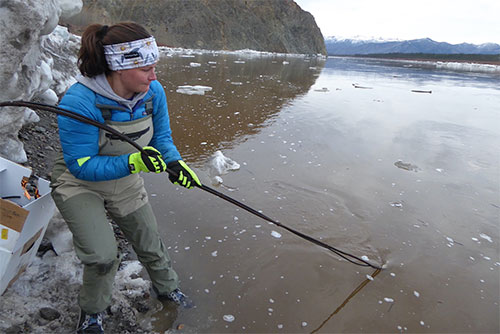
Wading into the icy Yukon River for science
By NED ROZELL
Liz Richards, a USGS hydrologic technician, pulls an anchor attached to a river-level measuring device from the Yukon River just downstream of Eagle, Alaska.
Photo by Ned Rozell |
|
Alaska: Wading into the icy Yukon River for science By NED ROZELL -
Snow geese flew in a ragged V overhead, rasping as they looked down upon Alaska’s bumpy face for the first time in 2022.
Nine hundred feet below, the Yukon River flowed by quietly, except for the dull thuds of icebergs skidding along the river bottom near the shore.
Sensing a break in the ice traffic, U.S. Geological Survey hydrologist Heather Best — wearing chest waders with a hole she would soon discover — stepped into the river. In both hands, she held a 3-foot portion of grader blade. Running along the blade was river-measuring tube secured by hose clamps.
That hunk of steel held the business end of a device Best and others use to measure the flow of the Yukon River at Eagle, a town of about 110 people just downstream of the Canada border.
A few days earlier, ice formed by the cold air of winter had knocked the river-measuring instrument offline. During river breakup at Eagle, rising meltwater lifted a sheet of ice that had been in place most of the winter.
Brown water then ferried immense shards of ice downstream at about 5 miles per hour. Some of it crashed into the bank on an outer river bend just down from Eagle. Those icebergs ripped the river-measuring hose from the shore where it entered the river, shearing it in a few places.
Best and USGS hydrologic technician Liz Richards had driven from their office in Fairbanks to see if they could fix the instrument. They stopped at other waterways during the 10-hour journey, to see if stream information being sent to the internet was accurate and fix things that got dinged up as winter’s ice turned to water.
On the shoreline of the Yukon River, after an hour’s work that included scrambling over ice chunks large as pickups, Best and Richards had spliced the measuring tube where the ice severed it. They reattached it to the grader blade. Then came the trickiest part — the redeployment of the tube beneath the surface of the Yukon.
Trying to keep her time immersed in ice water to a minimum, Best sidestepped out on rocks she couldn’t see beneath the surface. Once the river reached the belt around her waist, she stopped.
Best heaved the grader blade as far as she could into the water. She then retreated toward the shore. - More...
Sunday - May 22, 2022
What is monkeypox? A microbiologist explains what’s known about this smallpox cousin
By RODNEY E. ROHDE - On May 18, 2022, Massachusetts health officials and the Centers for Disease Control and Prevention confirmed a single case of monkeypox in a patient who had recently traveled to Canada. Cases have also been reported in the United Kingdom and Europe.
Monkeypox isn’t a new disease. The first confirmed human case was in 1970, when the virus was isolated from a child suspected of having smallpox in the Democratic Republic of Congo (DRC). Monkeypox is unlikely to cause another pandemic, but with COVID-19 top of mind, fear of another major outbreak is understandable. Though rare and usually mild, monkeypox can still potentially cause severe illness. Health officials are concerned that more cases will arise with increased travel.
I’m a researcher who has worked in public health and medical laboratories for over three decades, especially in the realm of diseases with animal origins. What exactly is happening in the current outbreak, and what does history tell us about monkeypox?
A cousin of smallpox
Monkeypox is caused by the monkeypox virus, which belongs to a subset of the Poxviridae family of viruses called Orthopoxvirus. This subset includes the smallpox, vaccinia and cowpox viruses. While an animal reservoir for monkeypox virus is unknown, African rodents are suspected to play a part in transmission. The monkeypox virus has only been isolated twice from an animal in nature. Diagnostic testing for monkeypox is currently only available at Laboratory Response Network labs in the U.S. and globally.
The name “monkeypox” comes from the first documented cases of the illness in animals in 1958, when two outbreaks occurred in monkeys kept for research. However, the virus did not jump from monkeys to humans, nor are monkeys major carriers of the disease. - More...
Sunday - May 22, 2022
|
PETER FUNT: HOLLYWOOD, LIKE SOCIETY, HAS TROUBLE WITH THE TRUTH - We’re living in gray times, bobbing in a sea of information where there is no longer much black or white. We have access to more content than ever — plus raging uncertainty about how much is fact or fiction.
Some folks are convinced they can’t trust politicians or news reporters or even medical experts, and it often seems that no amount of Googling gets us to the truth of many matters. Which brings me to Hollywood and its current crop of films and quasi-documentaries.
Example: Paramount+ is running a 10-part series called “The Offer,” about the making of 1972’s mob epic “The Godfather.” It’s riveting and made all the more compelling by the implication that this is the real backstory of Francis Ford Coppola’s classic. Turns out screenwriter Michael Tolkin got rather carried away in inventing plot lines. He’s been quoted as saying he prefers to forget what’s real and what’s not and “just write.”
Consider the recent Netflix multi-parter “Inventing Anna,” about the con artist who called herself Anna Delvey. The series is based on a well-reported piece in New York magazine, but by the time it was massaged by Hollywood — and padded to fill nine installments — it required the snarky on-screen disclaimer: “This whole story is completely true, except for all that parts that are totally made up.”- MORE...
Sunday - May 22, 2022
MICHAEL REAGAN: BIDEN IS COLOR BLIND ON SHOOTINGS - On and on it goes.
Another lone wacko, a white 18-year-old, went on a well-planned killing spree in a supermarket in a Black neighborhood of Buffalo.
It was a terrible, tragic, evil, obviously racist act.
Ten innocent people died and three were injured last weekend – 11 victims were Black.
We know the “alleged” killer was a white supremacist, an anti-Semite and a nut-job who clearly set out to kill Black people because of what he posted online.
Predictably, President Biden seized on the slaughter in Buffalo as further “proof” of his bogus claim that “the poison” of white supremacy poses the greatest threat to America today.
Also predictably, Biden and the usual liberal chorus of media outlets tried to link the country’s latest mass killing to Republicans, guns and Fox News stars like Tucker Carlson.
Biden went to Buffalo to show his sympathy for the victims, which is fine.
But as usual he was very selective when pointing out recent examples of racially motivated mass murders. - More...
Sunday - May 22, 2022
FINANCIAL FOCUS: Harness the power of budgeting Provided By BEN EDWARDS, AAMS® - When you hear the word “budgeting,” your first thought might be that it’s mostly for young people starting out in their careers and adult lives. Yet, budgeting can be important for everyone, no matter their age. And even if you feel that you’re in pretty good financial shape, with a reasonable amount of savings and investments, you can still benefit by establishing a budget or improving your current one.
Here’s what budgeting can do for you:
• Give you feelings of control – Not knowing where your money is going can be bewildering. But when you follow a budget, you’ll get a clear picture of your money movements. Consequently, you’ll feel more in control of your finances – and possibly your life, too.
- More...
Sunday - May 22, 2022
|
POLITICAL CARTOONS

Political Cartoon: UFO Hearing
by John Darkow©2022, Columbia Missourian
Distributed to subscribers for publication by CagleCartoons.com
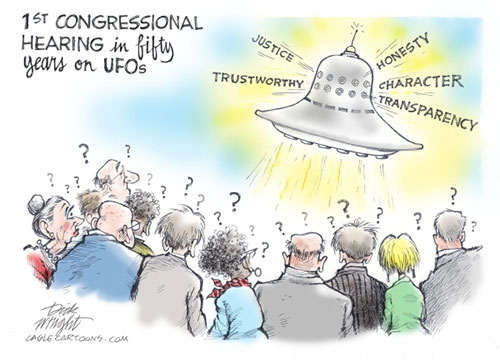
Political Cartoon: UFO Congressional Hearings
by Dick Wright©2022, PoliticalCartoons.com
Distributed to subscribers for publication by CagleCartoons.com
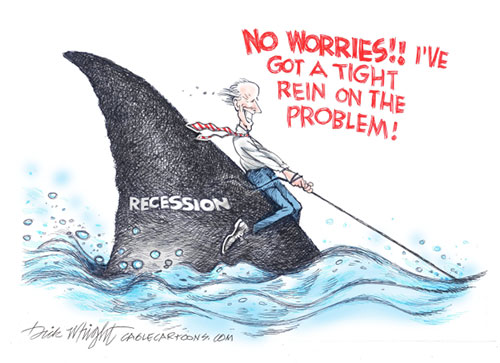
Political Cartoon: Biden Has Grip On Recession
by Dick Wright ©2022, PoliticalCartoons.com
Distributed to subscribers for publication by CagleCartoons.com

Political Cartoon: Counter-Inflationary Inflation
by Pat Byrnes©2022, PoliticalCartoons.com
Distributed to subscribers for publication by CagleCartoons.com

Political Cartoon: Military Delivers Baby Formula
by Daryl Cagle©2022, CagleCartoons.com
Distributed to subscribers for publication by CagleCartoons.com

Political Cartoon: Baby Formula
by Rivers©2022, CagleCartoons.com
Distributed to subscribers for publication by CagleCartoons.com
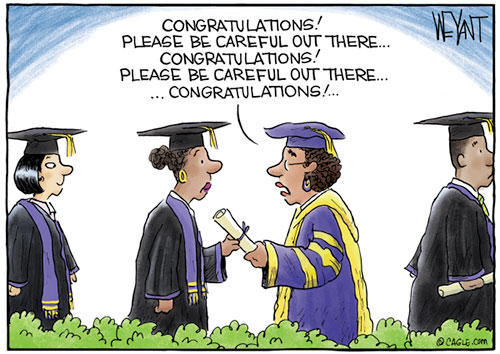
Political Cartoon: Graduation Worries
by Christopher Weyant©2022, CagleCartoons.com
Distributed to subscribers for publication by CagleCartoons.com |
Private School, State Reimbursement: Family Choice By Jodi Taylor
- Alaskan parents have a legitimate right to choose the school that is the best fit for their children, even if that is a private school. There is an opportunity - which has been hiding from public view - for families to use their children’s education allotment funded through the state’s Base Student Allocation (BSA) for classes at private schools, in addition to other educational options.
In 2014, educator and then-Senator Mike Dunleavy sponsored and carried to passage a statute that allows a parent or guardian of a correspondence study program student to use the student’s education allotment funded from the BSA to pay for classes at private schools, in addition to many other choices for accessing education. Fortunately for every parent and child stricken by COVID school restrictions, Governor Dunleavy recognizes that families are craving educational options. The guiding principle is that families have the right to determine where and how their children are educated.
Given our state’s low rankings in student outcomes and a steady stream of special interest policies, parents are finding it increasingly obvious that, at some schools, making sure their children learn enough to become successful adults is not the top priority. Now parents have more power to put the focus where it belongs!
Alaskan students may sign up for a correspondence study program (which is one of four types of homeschooling in Alaska), allowing parents to oversee their children’s education while receiving reimbursement for courses from approved vendors. Thanks to Dunleavy’s 2014 statute, private schools have been added to the list of allowable vendors for parents. These are the general steps for the Correspondence School Allotment Program. - More...
Sunday - May 22, 2022
Mass shootings: It’s the masculinity, people By Rob Okun - I'm beyond fed up that the gender of the murderers are still largely absent from conversations about America’s mass shootings crisis. In Buffalo, of course, racism and white supremacy cannot be overstated, but we ignore gender at out peril.
Let's tighten restrictions on poisonous hate speech on social media. It’s imperative we conduct threat assessments. Absolutely, more gun control regulations. We must deconstruct racist, anti-Semitic, homophobic, misogynist, white supremacist manifestos. But if we do all that and continue to minimize or ignore how these murderous men were socialized as boys and men, mass shootings will continue to plague us.
We have to start in preschool, carefully attending to how boys are socialized. We must cultivate their emotional intelligence. Who would deny the value of educating boys to examine their inner lives; to talk about their feelings?
Who in Congress is going to introduce legislation calling on the Centers for Disease Control (CDC) to conduct a nationwide study on how we socialize boys? Who is going to push for a comprehensive, multiyear pilot program with preschool boys in Head Start? The data amassed will help not just reshape our understanding of boys and men, but could ultimately transform masculinity.
The shooters’ gender remains central in my writing. Here’s a sampling of columns that, sadly, demonstrate how far we have to go: - More...
Sunday - May 22, 2022
The Effectiveness of Read by 9 Reforms By Debra Van Dyke
- Reading scores for Alaska’s public-school students are unsatisfactory. In fact, Alaskan fourth-grade reading scores across all incomes rank our students dead last in the nation. Considering the importance of being able to read by the age of nine, this is unacceptable. I am encouraged by actions taken recently in the Senate, and present data here to encourage the House to advance these distinct reforms. - More...
Saturday PM - May 14, 2022
 |
Capital Budget FY23 By Rep Dan Ortiz - This week, the Alaska State Legislature is finishing up work on the Capital Budget. Our priorities for capital projects this year are to use the additional revenue from this year’s high oil prices to take care of our aging infrastructure and past due obligations to districts. In FY20, only half of what was owed to communities for school bond debt reimbursement was paid, and nothing was paid in FY21. This year there is a $220 million appropriation to cover the difference in funding over previous years. This is great news for the communities of Ketchikan and Wrangell and their schools. The Legislature has also put $100 million toward the Department of Education’s major maintenance grant fund, and Ketchikan High school is set to receive just over $500 thousand for security upgrades from this fund, which was the main priority for the Ketchikan Borough Assembly Lobbying Executive Committee. - More...
Saturday PM - May 14, 2022
Email your opinions and letters for publication to editor@sitnews.us
|
Articles &
photographs that appear in SitNews may be protected by copyright
and may not be reprinted or redistributed without written permission
from and payment of required fees to the proper sources.
E-mail your news &
photos to editor@sitnews.us
Photographers choosing to submit photographs for publication to SitNews are in doing so, granting their permission for publication and for archiving. SitNews does not sell photographs. All requests for purchasing a photograph will be emailed to the photographer.
|
|











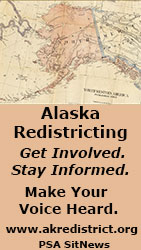
|
|
![]() Contact
Contact ![]()
![]() Webmail
Letters
Webmail
Letters![]()
![]() News Tips
News Tips![]()
![]() Copyright Info
Copyright Info![]() Archives
Archives![]() Alaska
Alaska![]() Ketchikan
Ketchikan![]() SE Alaska
SE Alaska![]() Dave Kiffer
Dave Kiffer![]() Money Matters
Money Matters ![]() June Allen
June Allen![]() Dave
Kiffer
Dave
Kiffer![]() Louise
B. Harrington
Louise
B. Harrington ![]() Ketchikan Links
Ketchikan Links![]() FAA Accident Reports
FAA Accident Reports ![]() NTSB
Accident Reports
NTSB
Accident Reports![]() Court Calendar
Court Calendar![]() Recent Filings & Case Dispositions
Recent Filings & Case Dispositions ![]() Court Records Search
Court Records Search![]() Sex Offender Reg.
Sex Offender Reg.![]() Public Notices
Public Notices![]() Alaska Recall Alerts
Alaska Recall Alerts![]() Recalls.gov
Recalls.gov![]() AST Daily Dispatch
AST Daily Dispatch![]() KTN
Police Reports
KTN
Police Reports![]() Juneau Police Reports
Juneau Police Reports ![]() Today's
Forecast
Today's
Forecast![]() KTN
Weather Data
KTN
Weather Data![]() AK
Weather Map
AK
Weather Map![]() AK Weathercams
AK Weathercams![]() AK Earthquakes
AK Earthquakes









































